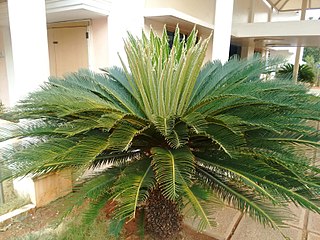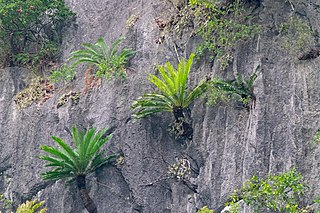
Cycas is a genus of cycad, and the only genus in the family Cycadaceae. About 113 species are accepted, which are native to the Indo-Pacific, East Africa and Madagascar. Cycas circinalis, a species endemic to India, was the first cycad species to be described in western literature, and is the type species of the genus. The best-known Cycas species is Cycas revoluta.

Cycas circinalis, also known as the queen sago, is a species of cycad known in the wild only from southern India. Cycas circinalis is the only gymnosperm species found among native Sri Lankan flora.
Rafflesia mira is a member of the genus Rafflesia. It is endemic to the rainforest of Mindanao, Philippines and can only be found in the vicinity of Mount Candalaga, Compostela Valley province. The species was described later in 2005 by Madulid et al., as R. magnifica, but this name is a later synonym. According to the IUCN the species is found in only one unprotected locality: Mt.Candalaga Range in Maragusan, Compostela Valley, where the individuals are distributed in small groups. A road infrastructure project is planned on part of the mountain. Moreover, the lower mountain slopes are being converted into banana plantations. Currently there are not any protective measures in place.
Cycas ferruginea is a plant species native to Vietnam and to the Guangxi region of China. It grows on rocky crevices in forested areas at elevations of 200–500 m. It is known from a belt of limestone bluffs in Lang Son Province and Thai Nguyen Province in Vietnam, and in western Guangxi Province, China. It is also cultivated at the Guilin Botanical Garden, Guangxi.

Cycas chevalieri is a species of cycad in central Vietnam, including in Nghe An Province. It may also occur in Laos.
Cycas collina is a species of cycad. It is found in the Mai Sơn area of Sơn La Province, Vietnam and in Sipsongpanna, Yunnan, China. It may also exist in Laos and Myanmar.
Cycas curranii is a species of cycad endemic to the Philippines.
Cycas elongata is a species of cycad endemic to southern Vietnam.

Cycas sexseminifera is a species of cycad in northern Vietnam and southern China.
Cycas segmentifida is a species of cycad endemic to southern China. It is found in primarily western Guangxi, as well as parts of neighboring southern Guizhou and eastern Yunnan.
Cycas pranburiensis is a species of cycad endemic to Thailand. It is found only in the Khao Sam Roi Yot National Park area of Prachuap Khiri Khan Province. It is named after Pran Buri District in Thailand, where it was discovered.

Cycas petraea is a species of cycad endemic to Thailand.
Cycas papuana is a species of cycad endemic to Papua New Guinea. It is found in Western Province, including the floodplains of the Fly River and near Daru to the west, and also extending to the Bensbach River.
Cycas hoabinhensis is a species of cycad endemic to central Vietnam, where it is found in Hoa Binh, Ha Nam, Ha Tay, and Ninh Binh provinces.
Cycas macrocarpa is a species of cycad in Malaysia and Thailand.

Cycas zambalensis is a species of cycad endemic to Luzon, Philippines.

Cycas wadei is a species of cycad endemic to Culion island, Philippines. There is only one subpopulation of about 5,000 mature individuals, located in a small area to the east of Halsey Harbor.

Cycas tropophylla, the Ha Long cycad, is a species of cycad endemic to Vietnam.
Cycas saxatilis is a species of cycad found only on Saint Paul's Mountain in Palawan at Philippines.
Cycas shanyaensis is a species of cycad endemic to Hainan, China.









